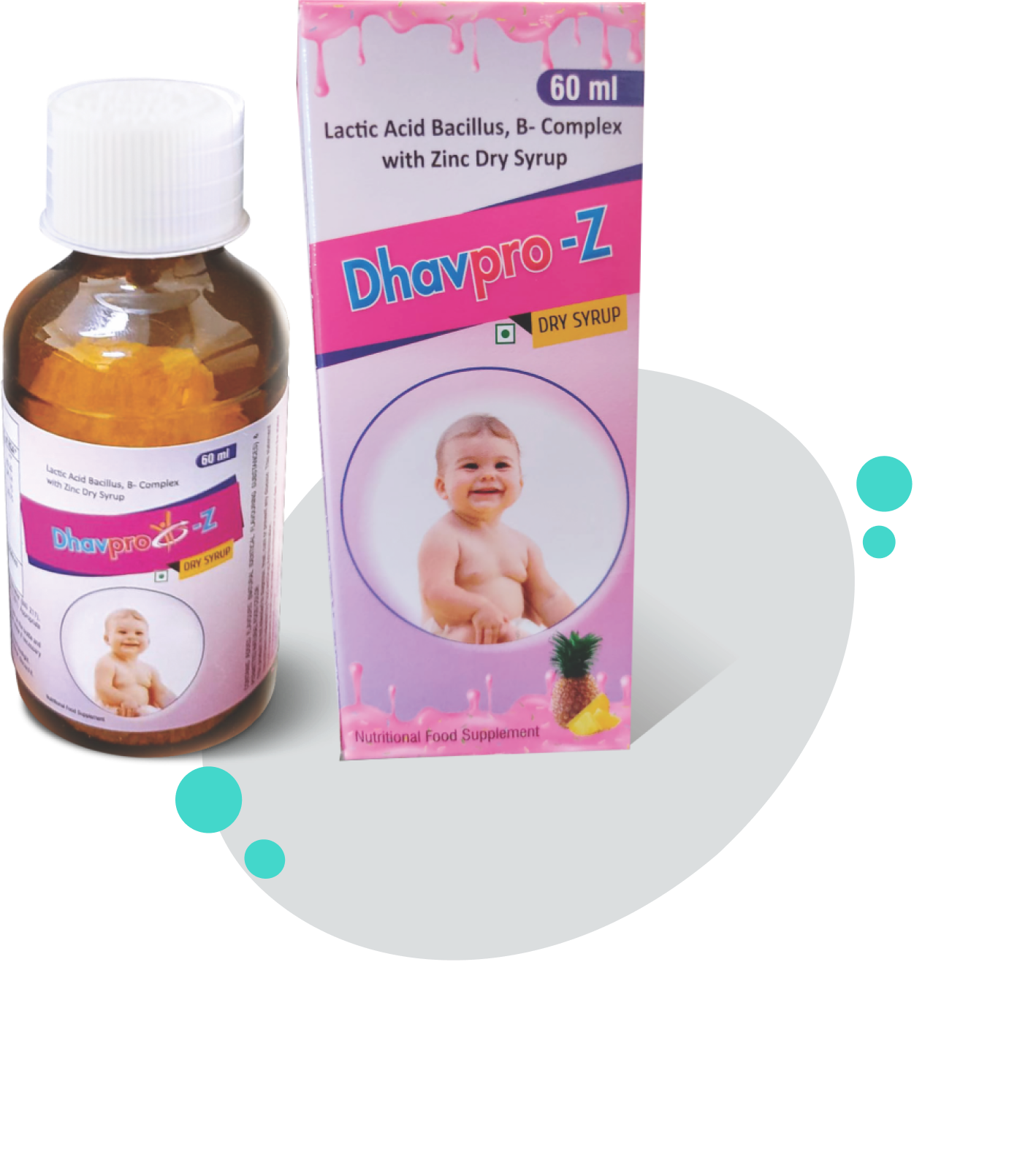
Dhavpro-Z Dry Syrup
Composition
Each 5 ml contains:
| Lactobacillus: | 100 Million Spores |
| Nicotinamide: | 15 mg |
| Folic acid: | 100 mcg |
| Pyridoxine: | 1.5 mg |
| Zinc: | 10 mg |
| Flavour: | Delicious Pine Apple |
Inroduction
Even today, Diarrhoea is a leading cause of morbidity and mortality among children <5 years of age around the world. Though the use of oral rehydration therapies has helped to reduce diarrhoea-related mortality, still there has been little improvement in the incidence rates for diarrhoea in recent times.
Use of probiotics to prevent antibiotic-associated diarrhoea in children2
Human gastro-intestinal tract is inhabited by more than 400 species of bacterial flora, and a balance of these intestinal micro-organisms is important for normal gastrointestinal function.
Treatment with broad spectrum antibiotic may disturb the colonization of gastrointestinal flora, leading to a range of symptoms, most particularly, diarrhoea. In particular, antibiotics such as beta-lactam antibiotics – Penicillins, Cephalosporins and Clindamycin which act on anaerobes that are commonly associated with diarrhoea.
In addition to abdominal pain, frequent watery bowel movements and antibiotic-associated diarrhoea (AAD) are associated with changed intestinal microflora, mucosal integrity, vitamin and mineral metabolism. Antibiotic-associated diarrhoea may lead to disturbances in electrolyte balance, depletion of volume, pseudomembranous colitis, contaminated colon and rarely death.
The prevalence of antibiotic-associated diarrhoea in the general population ranges from 5 to 62% that happens at any point from the initiation of therapy to two months after the end of treatment. However, the occurrence of diarrhoea in children treated with broad spectrum antibiotics is in the range of 11 to 40%. It was observed that there is an overgrowth of many pathogens in the intestines that has been associated with antibiotic induced diarrhoea. Overgrowth of Clostridium difficile is associated commonly with AAD. In majority of cases, most serious adverse events are associated with C. difficile diarrhoea. C. difficile infections happen most frequently in older, immunocompromised, hospitalized adults, but also takes place in children.
Probiotics are “friendly” non-pathogenic bacteria or yeast that colonise intestinal microflora and benefit many ways. Probiotics improve balance in microbial flora in the intestinal tract and display both antibacterial and immune strengthening actions.
Probiotics commonly used are Lactobacillus acidophilus, Lactobacillus bulgaris, Lactobacillus casei, Lactobacillus rhamnosus, Bifidobacteria bifidum, Bifidobacteria longum, Streptococcus thermophilus, Saccharomyces boulardii and Clostridium butyicum.
Role of Lactic acid bacillus
Lactic acid bacillus are bacteria that are good for our gastrointestinal tract. They inhibit the development pathogenic bacteria producing diarrhoea. Therefore, this probiotic helps in treating bacterial infections.
There are many more potential health or nutritional benefits with lactic acid bacteria. These include improvement in nutritional value of food being taken, control of infections of intestinal, enhanced digestion of lactose, immunity strengthening, lowering of cholesterol levels etc.
Role of Nicotinamide
One of the symptoms of Nicotinamide deficiency is Diarrhoea apart from skin problems and Dementia.4
There are two sources of Vitamin B3, one is Niacinamide and another is Niacin2.
Though Niacinamide and nicotinic acid have vitamin B3 activity, they differ in their chemical structure and how they boost the health3.
Nicotinamide helps convert food into energy by aiding enzymes4. Nicotinamide prevents several important enzymes which require NAD+ that control various pathways involving cell adhesion, migration, proliferation, and differentiation.5
Role of Zinc acid
There is an increased loss of Zinc in faeces, leading to lower zinc in the body, and low tissue zinc concentrations in children with diarrhoea.
Supplementation with Zinc reduces diarrhoea incidence. Zinc supplementation shortens the duration of diarrhoea by 15%–24% and also severity of the diarrhoeal episodes. Zinc1.
Role of Folic Acid
Malnutrition shown to be one of the risk factors for diarrheal disease and is the primary cause of 61% of childhood deaths due to diarrhoea globally. Micronutrient malnutrition reduces immune function and, therefore, enhances the vulnerability of a child to infections. It also leads to delayed full recovery, and enhances the possibility of severe sickness developing.
Folic acid is one of the important micronutrients for overall health and also been shown to prevent and treat diarrheal disease in young children.1
Role of Pyridoxine
Pyridoxine is one of the important Vitamin in Vitamin B group. Pyridoxine is one of the forms of vitamin B6 that is used to prevent or treat vitamin B6 deficiency. Deficiency of Vitamin B6 leads to severe diarrhoea or malabsorption diseases6 in children.
Dosage
5 ml twice a day
Packing
60 ml
Storage Conditions
Storage in cool, dry & dark place below 25⁰C. Protect from direct sunlight.
References
- https://academic.oup.com/cid/article/45/Supplement_1/S73/358052
- Cochrane Database of Systematic Reviews 2019, Issue 4. Art. No.: CD004827.
- https://www.medicoverhospitals.in/medicine/niacinamide
- https://www.healthline.com/nutrition/niacin-benefits#TOC_TITLE_HDR_3
- https://www.sciencedirect.com/topics/medicine-and-dentistry/nicotinamide
- https://www.sciencedirect.com/topics/medicine-and-dentistry/pyridoxine
Got a question?
We’d love to talk about how we can help you.